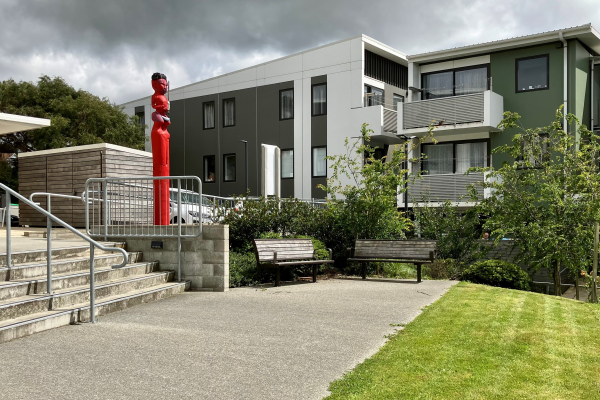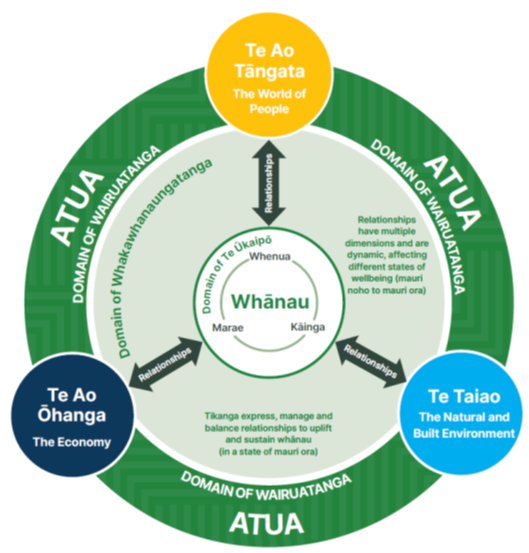Summary
Significant effort is underway to address the housing crisis in Aotearoa New Zealand including rapid investment in public and community housing. Māori are highly urbanised and face many systemic barriers to home ownership and private rental. Consequently Māori make up a significant proportion of public housing tenants. Developing and managing housing and associated neighbourhoods that support Māori wellbeing is of critical importance.
To help the movement toward culturally responsive housing and urban environments, members of the New Zealand Centre for Sustainable Cities have developed A Whakawhanaungatanga Māori Wellbeing Model for Housing and Urban Environments. The model is for use by researchers, developers, designers, managers and regulators. It emphasises whakawhanaungatanga (relationship building and creating opportunities for connectedness), which are central to the wellbeing of Māori.
Housing and urban Infrastructure’s role in wellbeing
All people have common wellbeing needs, yet wellbeing is shaped by individual and group characteristics, with culture being a key factor.1 This awareness has led to transformations in approaches to shaping landscapes and the built environment to better support wellbeing.2 Due to the work of many Māori leaders and culturally mindful urban and housing design practitioners over several decades, urban design and planning approaches in Aotearoa are starting to embrace indigenous approaches to wellbeing.3 This includes consideration of the relationships neighbourhoods and urban developments have to natural landscape features, historic settlement patterns, productive zones (gardens, forests, estuaries, natural nurseries) and social and cultural amenities, as well as opportunities for work and learning. Consideration also extends to the provision of housing.4
As part of urban infrastructure that helps optimise wellbeing,5 housing is critical, particularly as home is where whānau spend most of their time.6 High quality housing – including secure, healthy, affordable housing for those who would otherwise lack access to housing – is essential for protecting and enhancing wellbeing.7 Housing that is located, arranged and designed to meet the needs of Indigenous peoples is an important consideration for public housing providers in Aotearoa/New Zealand.8
For Māori, home environments – both as physical entities and as social and cultural settings – extend beyond the physical dwelling to include the surrounding natural and built environment. Incorporating the wider community and landscape in the conceptions of ‘home’ underscores the many and varied relationships that individuals, their whānau and communities experience with other places and people, and are therefore critical for supporting health and wellbeing by reinforcing identity, belonging and sense of place. Our model reflects the ecological-spiritual basis of wellbeing, and the central role indigenous approaches play in indigenous wellbeing. It is this nuanced approach, emphasising relationship building, that we are advocating for in our Whakawhanaungatanga Māori Wellbeing Model.9
A Whakawhanaungatanga Māori Wellbeing Model
Our model is arranged as three domains (Wairuatanga; Whakawhanaungatanga and Te Ūkaipō – see Appendix One) and highlights three relationship areas (the bi-directional nature of which is indicated by the two-way arrows):
1. Te Ao Tāngata: whānau, people in the community or elsewhere, tūpuna or others who have passed on;
2. Te Taiao: landscapes, nature, the environment including the built environment; and
3. Te Ao Ōhanga: local/community economy, cottage industries, processes of local exchange and sharing, community work and skill development that may sit outside mainstream economy.
Applying the model to Public Housing and Urban Development
To help interpret and apply these concepts, we have developed a set of questions to guide research and approaches to Māori wellbeing in a public housing and urban context. The questions are arranged according to the seven key concepts (see Appendix Two), and span the physical environment, and the social and cultural environment where these concepts act to affect wellbeing. An example from the first key concept is shown below:
|
1: Relationships are a Primary Determinant of Māori Wellbeing
|
|
Physical Environment
|
Social and Cultural Environment
|
- Do kāinga and urban design address all dimensions of whānau wellbeing – spiritual, mental and physical?
- Are toi/tohu/kupu and te reo Māori included in/on kāinga and infrastructure to demonstrate relationships with the local environment, hapū/iwi and important ancestors and events?
- Traditional Māori design is imbued with meaning and symbolism and forms an important part of Māori identity and culture. Are Māori designs visible and evident in the built form and used to tell locally relevant stories and reinforce Māori identity?
- Are kāinga designed from a long-term and multi-generational perspective?
|
- Are kāinga and urban planning, design, development and management informed by the views of mana whenua and mātāwaka?
- Are mana whenua and mātāwaka groups equitably involved in governance, planning and design?
- Are kāinga and urban design and development supported by appropriate cultural practices, ceremonies and rituals (e.g. karakia, blessing, rahui) as determined by Māori?
- Is the history and whakapapa of the kāinga and whenua known to public housing residents?
- Are place-based stories and pūrākau (legends) associated with the street, neighbourhood, and community available and known to residents and community?
- Do residents/whānau have equal decision making around locational choices?
|
We provide this model as a new resource to help guide those in the built environment sector to create spaces that enable Māori wellbeing. (For more information see the published paper). We acknowledge that public housing providers operate within a political, economic and regulatory environment that limits the extent to which they can affect change in the public realm. There are areas, however, where even within significant constraints, meaningful change can be effected. The adoption of a holistic, Māori-centric view of wellbeing that validates and legitimises Te Ao Māori values, principles and relationships is required if public housing is to fulfil its potential as an enabler of Māori wellbeing.
What is new in this briefing?
- We present A Whakawhanaungatanga Māori Wellbeing Model that centres the importance of relationship building.
- Seven key concepts identified in the literature inform the model, with each concept playing a role in supporting Māori wellbeing.
- The model emphasises the importance of supporting whakawhanaungatanga and creating opportunities for connectedness between people (present and past), the natural environment and the local and wider economy, with connectedness taking different forms (e.g. physical, emotional, spiritual).
- The model highlights the importance of applying wairuatanga, tikanga and te reo to relationships in the built environment and having access to ūkaipō to support wellbeing processes.
- Our published paper also provides a series of questions to help guide researchers and built environment designers and practitioners apply the model when considering the wellbeing of Māori.
Implications for public health:
- The practice of whakawhanaungatanga, with its foundation in te ao Māori, facilitates the expression of Māori values and principles in urban spaces.
- The model provides the basis for a framework to assess the extent to which housing and urban environments support Māori wellbeing.
- Enabling the practice of whakawhanaungatanga creates housing and urban environments that support hauora Māori (Māori health and wellbeing), making healthy places for all to enjoy.
Author details
Dr Guy Penny, Dr Kimberley O’Sullivan and Dr Amber Logan-Riley. New Zealand Centre for Sustainable Cities | Te pokapū ronaki taone-nui, Department of Public Health Wellington, University of Otago Wellington.
Appendix One
Our model is arranged as three domains; Wairuatanga; Whakawhanaungatanga and Te Ūkaipō. The Domain of Wairuatanga (spirituality) acknowledges the intrinsic place of spirituality in all aspects of Te Ao Māori, and permeates the other domains. Within the domain of Te Ūkaipō (source of Te Ao Māori; a place of oranga ngakau, healing and nourishment) relationships are based on Te Ao Māori whereas in the domain of Whakawhanaungatanga relationships are negotiated or imposed, and in the lived reality of many urban Māori are predominantly based on non-Māori constructs in non-Māori settings, leading to less than optimal wellbeing outcome While it is important that the domains of Wairuatanga and Te Ūkaipo are active and robust, it is within the domain of Whakawhanaungatanga, a negotiated space, that the work of re-balancing, forming, strengthening and maintaining of connections and relationships is done. This is where those working on developing, designing and facilitating the provision of public housing and urban environments should focus their effort to enable Māori wellbeing.
Appendix Two
Reviewing literature that centres Te Ao Māori, the built-environment, and wellbeing literature, we identified seven key concepts fundamental to understanding Māori wellbeing and the built environment: 1) Relationships as the primary determinant of wellbeing; 2) Wairuatanga (spirituality) as the foundation of wellbeing; 3) A focus on Whānau (families) and Kāinga (home); 4) The role of Tikanga (custom, protocol); 5) Balance between mauri noho (languishing) and mauri ora (flourishing); 6) Identity and Cultural Landscapes, and 7) Te Ūkaipō (cultural origin/home ). These concepts effect wellbeing through their physical expression as well as being socially constructed (and therefore contestable) and are evident in our model (see figure above).


